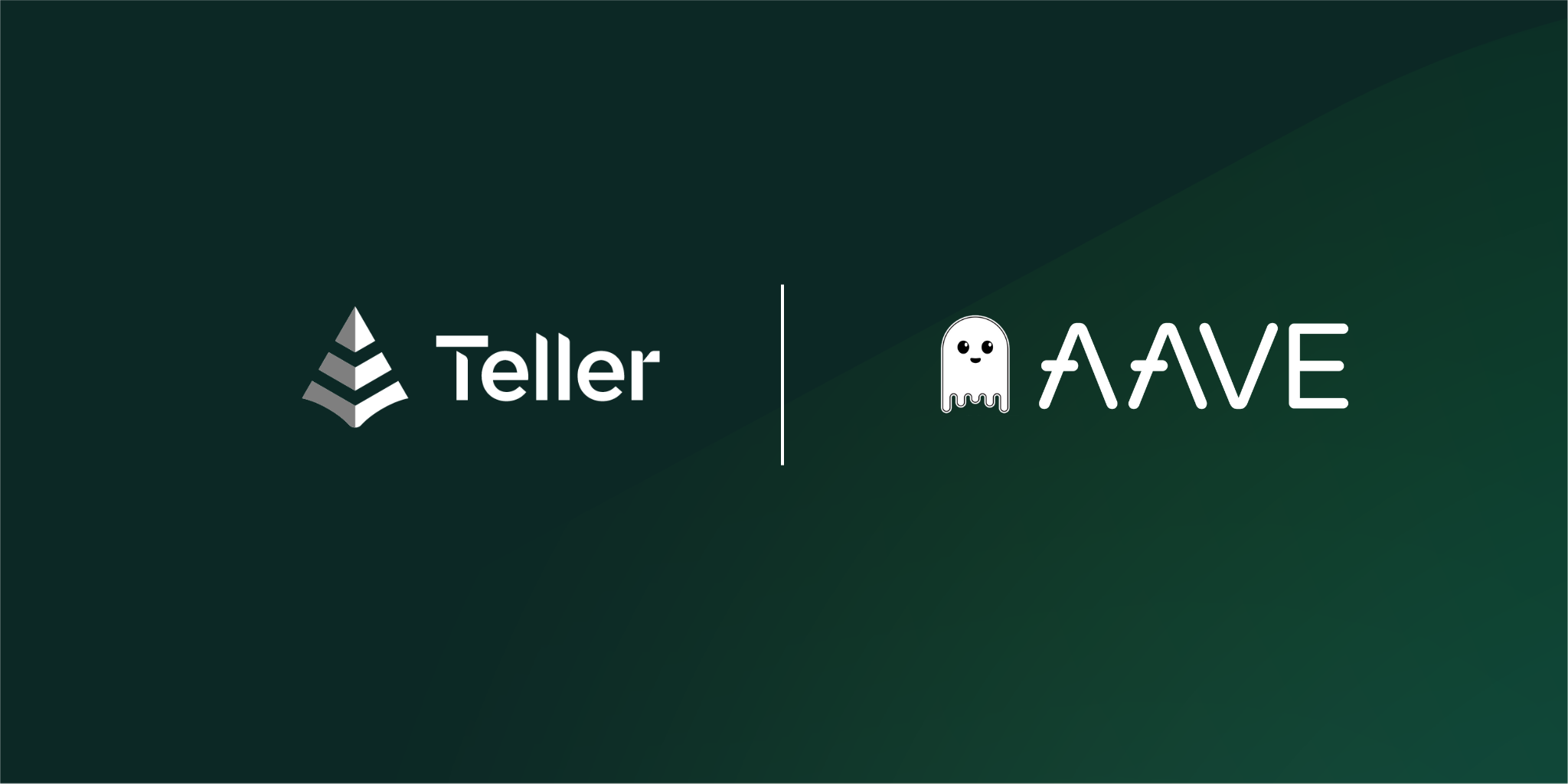Teller vs Aave - Redefining the Future of Crypto Lending and Borrowing Platforms

The recent years in the crypto space have seen the emergence of Decentralized finance (DeFi) as one of the hottest topics. DeFi imagines and promotes an open global financial system capable of functioning without intermediary parties such as clearing houses, banks, and insurance companies. DeFi companies strive to build a simple, swift, and secure financial ecosystem that is accessible to everyone with the internet on their devices. It is trying to bring the entire traditional financial market to the blockchain systems to ensure efficiency, transparency, and decentralization. A system like this is accessible on the internet to everyone with little knowledge about crypto assets.
In this article, we will discuss two leading DeFi lending and borrowing protocols that are changing the world of finance with decentralization and smart contracts as we see them today, Aave and Teller. Before we jump to the comparison between Aave and Teller, we first need to understand the underlying mechanism and process running on both of these protocols.
What is Teller
Teller protocol is a decentralized protocol that is making uncollateralized and undercollateralized loans accessible to the masses. It enables secured and unsecured DeFi digital asset borrowing and lending using an open order-book model. The platform also helps borrowers to bridge their off-chain data onto on-chain crypto loan requests.
Borrowers can request crypto loans on the platform by filling in the details on the platform, while the lenders supplying assets to meet the loan demands can commit to a request of their choice. There is a direct transaction between the borrowers and the lenders if the latter decides to comply with the loan conditions of the former. The borrower’s information includes details such as identity information, credit history, other loans active and other relevant data.
Teller hosts three types of users on its lending protocol.
- Marketplace owners such as creators, entrepreneurs, and developers who wish to launch a new lending pool. They can initiate their lending book within the protocol by building a simple front-end user interface. The users can then borrow market-specific crypto loans by connecting the required data support.
- Lenders fill requests raised by borrowers or create their criteria for commitments based on the rules and requests of asset data. They can place another request serving as a counter to the requests raised by the borrowers.
- Borrowers are the ones who request loans via the Teller’s platform. Borrowers can choose a pool on Teller’s marketplace that is favorable to their conditions. Some of the pools currently hosted by Teller are Ape Now- which allows you to buy NFTs instantly and pay later. USDC Homes- this market allows uncollateralized crypto loans for residential mortgages, Koala B2B is a travel protection crypto loan, etc.
What is Aave
Aave is a decentralized finance protocol letting people borrow and lend crypto. Lenders on this platform can earn interest by depositing their crypto assets into the liquidity pools created by liquidity providers on the platform. Borrowers then have to use their crypto as collateral to receive a crypto loan using liquidity.
Aave was launched in the year 2017 and was originally known as ETHLend. However, it was rebranded to Aave in the year 2018. Aave also provides its holders with some discounts on the platform. The AAVE token serves as its governance token, giving voting rights for future developments and operational changes within the protocol. Aave became one of the most popular DeFi lending protocols during the DeFi craze of 2020, as it was one of the first liquidity pool-driven lending platforms on the Ethereum blockchain. It emerged as one of the biggest decentralized finance projects in terms of total value locked in the protocol.
Aave allows its users to lend and borrow in almost 20 crypto assets. One of the unique offerings of Aave is the Flash Loans. This product was considered one of the first uncollateralized loans in the DeFi space. However, these uncollateralized loans were open only for a few minutes and had to be paid back within a few minutes or hours in the same transaction. Aave also lets its users alternate between variable and fixed rates.
- Teller has recently collaborated with Chain Link, the world's leading decentralized oracle network, and DECO to create a proof of concept to issue undercollateralized crypto loans using zero-knowledge proofs to attest to off-chain information.
We are excited to have collaborated with @chainlinklabs on a successful proof of concept for undercollateralized lending.
— Teller (@useteller) September 16, 2022
In this alpha test, Teller used #Chainlink DECO, the privacy-preserving oracle protocol, to verify off-chain bank account balances. https://t.co/q7FBq9O99b
- Roofstock, one of the world’s leading online marketplace for real estate investors in the single-family rental (SFR) home sector, will be leveraging the Teller protocol to enable the financing of real estate properties using USDC Homes.
📢We are excited to announce that @Roofstock has leveraged Teller Protocol to enable the financing of tokenized real estate properties
— Teller (@useteller) October 18, 2022
Their Web3 platform @rsonchain & Teller has made it possible with USDC Homes, a DeFi lending pool built on @0xPolygonhttps://t.co/XTCnbw5dDc
| Features | Aave | Teller |
|---|---|---|
| Launch date | November 2017 | September 2020 |
| Blockchain Protocol | Ethereum (with support of other blockchains like Polygon) | Ethereum (with support of other blockchains like Polygon) |
| Token | AAVE | NA |
| Uncollateralized Loans | Only Flash loans | Multiple types of uncollateralized loans available |
| Collateral | Over-collateralized loans | Variety of collateral options available |
| Undercollateralized loans | No | Building with DECO and Chainlink |
| Institutional Support | Yes | Yes |
| Markets other than Crypto | No | Yes, like NFTs and Real Estate |
| Lending Mechanism | Pool to peer | Both pool to peer and peer to peer |
Aave vs. Teller - The Ultimate Comparison
Pros of Teller
- User-friendly interface.
- Simple and easy to avail uncollateralized loans
- Users can create their own marketplaces for borrowing and lending.
- Multiple financial marketplaces available.
- Transparent and immutable loan books available.
- Flexibility for lenders and borrowers to set their own loan conditions.
- Both pool-to-peer and peer-to-peer lending model possible
Pros of Aave
- Huge lending pool available with massive value locked in smart contracts
- Stable interest rates for few crypto assets
- Completely DAO based with decentralized governance and pool-to-peer lending model
Cons of Teller
- The customer base and LP base are currently smaller than Aave
- Too many pools with not much info on the pool themselves because they are relatively new
Cons of Aave
- Not as user-friendly as Teller.
- Supports limited wallets
- Uncollateralized loans are available only in the form of flash loans.
- Lack of high incentives for the users to borrow or lend.
- Hackers have exploited Flash loans in the past.
Teller or Aave - What should you pick and when?
Aave is one of the leading and largest cryptocurrency projects competing well against its rivals like Maker and Compound. Aave has made the start-to-end lending and borrowing process super simple through blockchain technology without requiring the users to depend on a centralized party. It also released a decentralized collateralized stablecoin called GHO in July 2022.
Aave introduced the concept of earning rewards by contributing liquidity to lending pools in crypto. However, Aave only provides collateralized loans, most of which are over-collateralized. For users who wish to avail of a zero-collateral crypto loan, Aave is not the right option. Aave has the concept of Flash loans, but these loans are open only for a few minutes and must be closed within a single transaction. You have to be lucky and fast enough to avail of such loans. Teller, on the other hand, is the perfect fit for someone looking for an undercollateralized crypto loan. Teller is removing various limitations and shortcomings existing in ‘traditional’ DeFi platforms. It is innovating the space with features supported by creative solutions that expand the potential of the entire crypto lending and borrowing industry.
Teller lets its users become major players in the next generation of fintech solutions by letting them lend and borrow and, most importantly, helping them launch a market of their own. Like Aave, Teller markets are also built on Ethereum with additional support for other blockchains; therefore, it comes with industry's best security features and decentralization. Users can borrow or lend in several markets to their needs. Some of these are Ape Now, Pay later, a market to buy NFTs with an average APR of 23.88%. It also has other lending markets like Polytrade and ENS Lending Pool with an average APR of 6% and 20% respectively.
Teller also helps its users build an on-chain loan performance history by launching their own DeFi market. All you have to do is fill a form on the Teller protocol and wait for the Teller team to reach you out. Well, if you are one of those investors hoping to buy real estate with crypto mortgages, Teller comes handy even in such situations. USDC.Homes by Teller helps you borrow a crypto loan for your dream house.
The breadth of lending opportunities, Transparent and immutable loan books, the flexibility for the users to set their own terms all make Teller a go-to place for different users with varied needs. If you are looking for all the requirements mentioned above, Teller surely is the best platform you could ask for.
How to get started with Teller?
It's super simple and hassle free to start your lending and borrowing journey with Teller.
Step 1: Visit the official website of Teller.org.
Step 2: Connect your wallet. Several wallet options appear on the screen. Choose the relevant wallet option and connect it with Teller.
Step 3: Choose the financial market you wish to lend in or Borrow. You can choose from various markets like Tower Fund, Koala B2B , etc depending upon your needs.
Step 4: Once clicking on the relevant market all the details related to the same appear on the screen. While few require you to complete the KYC, others do not.
Step 5: Once the KYC is complete, fill the form usually present on the left hand side of the screen such as the amount , whether you wish to modify terms or not, etc.
And Voila! You will be one step closer to your lending and borrowing journey. It is as simple as this.
So what are you waiting for, visit Teller now and check out its services on your own.
